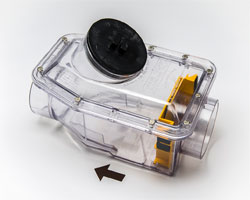Sump Pump & Back Flow Valve Installation
Municipalities do not guarantee that their storm and sanitary sewer systems will not backup. Insurance companies recommend that homeowners actively protect their basements from possible flooding. In fact, many Municipalities are actually paying home owners rebates for installing flood prevention devices that will reduce the amount of storm water that the City has to process. Click here to find out more about municipal rebates .
Insurance companies and municipalities recommend that all homeowners install backflow valves and sump pumps to mitigate against the risk of possible basement flooding.
Backflow valves

A backflow valve is a device that installs in the home’s main sanitary sewer line. Backwater check valves prevent sewage from backing up into a basement from an overloaded municipal sanitary sewer line. A backflow valve allows house sewage to pass in one direction toward the street sanitary sewer. But in the event that the City main sewer lines will be overfilled to capacity, sewage that normally will be flowing away from your house could reverse direction and be pushed back towards your house. When this situation occurs and if there is nothing stopping the backflow of sewage between your own drains and the outside, sewage laden water could freely enter your house and flood it with raw sewage sludge.
When a backflow valve is installed, a door located within the backwater valve housing automatically closes and acts as a barrier from sewage backing up, preventing raw sewage from entering your house.
When inline backflow valve is in the closed position, homeowners should be advised that during this situation that no in-house plumbing fixtures be operated. The reason being that sewage from within your house will have no place to go, traveling only as far as the closed door in the backwater valve. Otherwise, if toilets will be flushed, your own effluent could back up into your own basement drains and basement plumbing fixtures.
Sump pumps in sump pits
When there is an excessive amount of ground water from rain, the foundation weeping tiles may be overwhelmed and a situation could arise where water is not being removed fast enough into the storm water system and storm water starts backing up. Storm water under pressure will be forced into the basement from cracks in the basement floor and walls and from drains located in the house. In minutes, water under pressure could fill a basement and will continue to fill until there is equilibrium between outside water table and the height of water in the basement.
A sump pump located in a sump pit that is below the lowest point that water in a house collects allows ground water to fill the sump pit. When water reaches a certain height, the sump pump will start automatically to pump water out of the pit to the outside and then shut down. As water continues to fill, the sump pump will automatically start, pumping more water out of the pit.
Historically, cities wanted all water draining from roofs and downpipes to drain to city storm sewers. But the old system of storm water management is so undersized today that the amount of storm water generated during storms is increasingly too much for the city’s storm management system to handle. The result could be local or general flooding of streets and entire neighbourhoods.
The city now encourages property owners to install sump pumps in sump pits and recommends that all house storm water that used to be directed to storm sewers be diverted directly to the outside of the house. In fact in the City of Toronto, it is law that all down pipes be disconnected from the storm sewer system.
Do you qualify for financial subsidies?
Did you know that the City of Toronto will pay up $3,200 to home owners that will install devices that will reduce homeowners’ reliance on the City sewer systems? Municipalities are subsidizing homeowners because the cost to enlarge and update the City antiquated sanitary and storm sewers to a larger capacity is in the range of many hundreds of millions of dollars. It is less costly for municipalities to individually pay qualified homeowner a backwater valve rebate and sump pump rebate than to increase the existing sewage processing capacity.
Suppose the City did increase the sewage capacity. Would it be sized large enough for the next 1 in 20 years or 1 in 50 years rain that seems to be happening more frequently?
Don’t wait to upgrade your property. Take advantage of the substantial municipal subsidies up to $3,200 that available today.
Will these grants be available next year after the next damaging flood or storm? Certainly the remedial cost and disruption & inconvenience to your family will be a lot more costly than having us install flood prevention devices such as backflow valves, sump pits and sump pumps that could save your house from significant water damage.
Contact GreenCity Plumbers . Find out if you are qualified to receive the full or portion of the homeowner’s rebate for flood abatement devices.
Our Gallery
Our professional Toronto plumbing team has worked with countless Toronto property managers and Toronto GTA commercial & industrial property owners.
View AllGet a Quote
The Rise of Green Architecture
May 13 2016 by GreenCity Plumber
Green architecture is vastly becoming a popular option to help the environment in a stylish way. This type of architecture promotes sustainable energy sources and…
View AllI received a letter from the City to install a backflow preventer. My building is 30 years old. Why do I have to install the backflow preventer after all this time?
It’s the law. City bylaw says that all industrial, commercial, institutional ICI properties and multi-residential properties of more than 4 units...
View AllWhat People Say
My basement toilet laundry tub constantly backed up whenever I washed clothes. GreenCity Plumbers snaked the drains and cleared the clog. Everything works smooth now. Wonderful to have my pipes cleaned by GreenCity Plumber.
- RS, Oakville, HomeownerBackflow preventer had to be installed in main 4” water main feeding our apartment building. GreenCity Plumbers worked very closely with us during the installation of the backflow preventer because water in the building had to be shut down for several hours. Although 200 families were inconvenienced, GreenCity pre-assembled all parts and backflow preventer for fast assembly prior to... - AB, Residential Property Manager, North York
Water was gushing from the floor at our carwash was due to huge water leak in the 6 in original iron water pipe installed more than 50 years ago. Without water, our carwash is out of business. GreenCity Plumbers quickly found the water leak 6 feet below existing concrete floor and temporarily sealed leak in a badly perforated pipe, allowing our carwash business to operate. In the meantime,... - RMB, Car Wash Owner, North York
Old steam boilers seemed more off than on. GreenCity replaced old boilers with new gas fired Fulton boilers. Building tenants now come to work without any expectations of “no heat” now that the new boilers are installed.
- RSW, Commercial Building Landlord, TorontoAfter major storms, lower level of our 60 year old industrial building always flooded. GreenCity Plumber determined cause of flooding was due to building storm water being connected to an internal plugged French drain system on our property. Green City recommended that property storm water be diverted directly to City storm water drains. GreenCity prepared engineered drawings for the... - AS, Industrial Processing Business , Scarborough
Request A Quote



